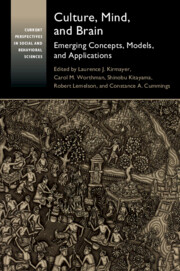Book contents
- Culture, Mind, and Brain
- Current Perspectives in Social and Behavioral Sciences
- Culture, Mind, and Brain
- Copyright page
- Dedication
- Epigraph
- Contents
- Figures
- Tables
- Contributors
- Preface
- Abbreviations
- 1 Introduction
- Part I Dynamics of Culture, Mind, and Brain
- Section 1 The Co-emergence of Culture, Mind, and Brain
- 2 Culture, Mind, and Brain in Human Evolution
- 3 Mutual Constitution of Culture and the Mind
- 4 Being There
- Section 2 The Situated Brain
- Section 3 How Social Coordination and Cooperation are Achieved
- Part II Applications
- Index
- References
2 - Culture, Mind, and Brain in Human Evolution
An Extended Evolutionary Perspective on Paleolithic Toolmaking as Embodied Practice
from Section 1 - The Co-emergence of Culture, Mind, and Brain
Published online by Cambridge University Press: 18 September 2020
- Culture, Mind, and Brain
- Current Perspectives in Social and Behavioral Sciences
- Culture, Mind, and Brain
- Copyright page
- Dedication
- Epigraph
- Contents
- Figures
- Tables
- Contributors
- Preface
- Abbreviations
- 1 Introduction
- Part I Dynamics of Culture, Mind, and Brain
- Section 1 The Co-emergence of Culture, Mind, and Brain
- 2 Culture, Mind, and Brain in Human Evolution
- 3 Mutual Constitution of Culture and the Mind
- 4 Being There
- Section 2 The Situated Brain
- Section 3 How Social Coordination and Cooperation are Achieved
- Part II Applications
- Index
- References
Summary
Ancient stone tools provide a unique source of empirical evidence for reconstructing the evolutionary origins of human culture, mind, and brain. As a key component of hominid adaptations throughout the Paleolithic, stone tools not only document human evolution but likely helped to shape it. Properly interpreting this evidence requires both “middle-range” theory linking archaeologically observable material remains to the behaviors that created them and high-level theory appropriate for placing these reconstructed behaviors in a broader evolutionary framework. An extended evolutionary perspective on Paleolithic toolmaking as embodied practice integrates levels of analysis by emphasizing the interaction of evolutionary and behavioral processes unfolding on multiple spatiotemporal scales. Although much work remains to be done, initial efforts toward an integrated evolutionary neuroscience of toolmaking are beginning to trace the evolution of a uniquely human technological niche rooted in a shared primate heritage of visuomotor coordination and dexterous manipulation.
Keywords
- Type
- Chapter
- Information
- Culture, Mind, and BrainEmerging Concepts, Models, and Applications, pp. 55 - 87Publisher: Cambridge University PressPrint publication year: 2020



